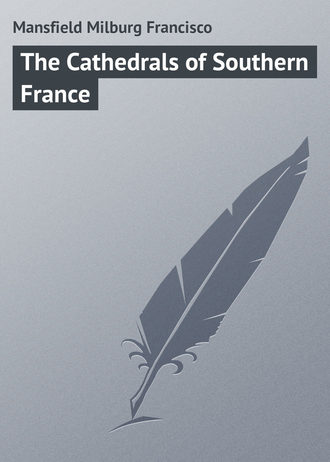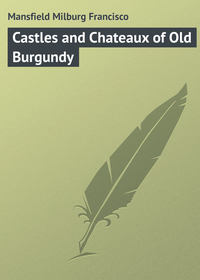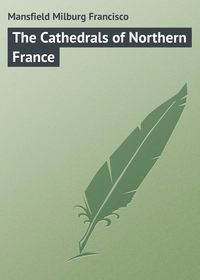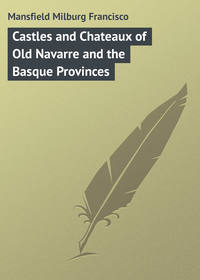 полная версия
полная версияThe Cathedrals of Southern France
The "Provence rose," so celebrated in legend and literature, can hardly be dismissed without a word; though, in truth, the casual traveller will hardly know of its existence, unless he may have a sweet recollection of some rural maid, who, with sleeves carefully rolled up, stood before her favourite rose-tree, tenderly examining it, and driving away a buzzing fly or a droning wasp.
These firstlings of the season are tended with great pride. The distinctive "rose of Provence" is smaller, redder, and more elastic and concentric than the centifoliæ of the north, and for this reason, likely, it appears the more charming to the eye of the native of the north, who, if we are to believe the romanticists, is made a child again by the mere contemplation of this lovely flower.
The glory of this rich red "Provence rose" is in dispute between Provence and Provins, the ancient capital of La Brie; but the weight of the argument appears to favour the former.
Below Arles and Nîmes the Rhône broadens out into a many-fingered estuary, and mingles its Alpine flood with the blue waters of the Mediterranean.
The delta has been formed by the activity and energy of the river itself, from the fourth century – when it is known that Arles lay sixteen miles from the sea – till to-day, when it is something like thirty. This ceaseless carrying and filling has resulted in a new coast-line, which not only has changed the topography of the region considerably, but may be supposed to have actually worked to the commercial disadvantage of the country round about.
The annual prolongation of the shores – the reclaimed water-front – is about one hundred and sixty-four feet, hence some considerable gain is accounted for, but whether to the nation or the "squatter" statistics do not say.
The delta of the Rhône has been described by an expansive French writer as: "Something quite separate from the rest of France. It is a wedge of Greece and of the East thrust into Gaul. It came north a hundred (or more) years ago and killed the Monarchy. It caught the value in, and created the great war-song of the Republic."
There is a deal of subtlety in these few lines, and they are given here because of their truth and applicability.
II
ST. ETIENNE DE CHALONS-SUR-SAÔNE
"The cathedral at Chalons," says Philip Gilbert Hamerton, – who knew the entire region of the Saône better perhaps than any other Anglo-Saxon, – "has twin towers, which, in the evening, at a distance, recall Notre Dame (at Paris), and there are domes, too, as in the capital."
An imaginative description surely, and one that is doubtless not without truth were one able to first come upon this riverside city of mid-France in the twilight, and by boat from the upper river.
Chalons is an ideally situated city, with a placidness which the slow current of the Saône does not disturb. But its cathedral! It is no more like its Parisian compeer than it is like the Pyramids of Egypt.
In the first place, the cathedral towers are a weak, effeminate imitation of a prototype which itself must have been far removed from Notre Dame, and they have been bolstered and battened in a shameful fashion.
The cathedral at Chalons is about the most ancient-looking possession of the city, which in other respects is quite modern, and, aside from its charming situation and general attractiveness, takes no rank whatever as a centre of ancient or mediæval art.
Its examples of Gallic architecture are not traceable to-day, and of Roman remains it possesses none. As a Gallic stronghold, – it was never more than that, – it appealed to Cæsar merely as a base from which to advance or retreat, and its history at this time is not great or abundant.
A Roman wall is supposed to have existed, but its remains are not traceable to-day, though tradition has it that a quantity of its stones were transported by the monk Bénigne for the rotunda which he built at Dijon.
The city's era of great prosperity was the fifteenth and sixteenth centuries, when its fortifications were built up anew, its cathedral finished, and fourteen churches held forth.
From this high estate it has sadly fallen, and there is only its decrepit cathedral, rebuilt after a seventeenth-century fire, and two churches – one of them modern – to uphold its ecclesiastical dignity.
The towers of the cathedral are of the seventeenth century, but the so-called "Deanery Tower" is more ancient, and suggestive of much that is militant and very little that is churchly.
The interior has been restored, not wholly with success, but yet not wholly spoiled.
In plan and arrangement it is a simple and severe church, but acceptable enough when one contemplates changes made elsewhere. Here are to be seen no debased copies of Greek or Roman orders; which is something to be thankful for.
The arches of the nave and choir are strong and bold, but not of great spread. The height of the nave, part of which has come down from the thirteenth century, is ninety feet at least.
There are well-carved capitals to the pillars of the nave, and the coloured glass of the windows of triforium and clerestory is rich without rising to great beauty.
In general the style is decidedly a mélange, though the cathedral is entitled to rank as a Gothic example. Its length is 350 feet.
The maître-autel is one of the most elegant in France.
Modern improvement has cleared away much that was picturesque, but around the cathedral are still left a few gabled houses, which serve to preserve something of the mediæval setting which once held it.
The courtyard and its dependencies at the base of the "Deanery Tower" are the chief artistic features. They appeal far more strongly than any general accessory of the cathedral itself, and suggest that they once must have been the components of a cloister.
The see was founded in the fifth century as a suffragan of Lyon.
III
ST. VINCENT DE MACON
The Mastieo of the Romans was not the Macon of to-day, though, by evolution, or corruption, or whatever the process may have been, the name has come down to us as referring to the same place. The former city did not border the river, but was seated on a height overlooking the Saône, which flows by the doors of the present city of Macon.
Its site is endowed with most of the attributes included in the definition of "commanding," and, though not grandly situated, is, from any riverside view-point, attractive and pleasing.
When it comes to the polygonal towers of its olden cathedral, this charming and pleasing view changes to that of one which is curious and interesting. The cathedral of St. Vincent is a battered old ruin, and no amount of restoration and rebuilding will ever endow it with any more deserving qualities.
The Revolution was responsible for its having withered away, as it was also for the abolishment of the see of Macon.
The towers stand to-day – lowered somewhat from their former proportions – gaunt and grim, and the rich Burgundian narthen, which lay between, has been converted – not restored, mark you – into an inferior sort of chapel.
The destruction that fell upon various parts of this old church might as well have been more sweeping and razed it to the ground entirely. The effect could not have been more disheartening.
Macon formerly had twelve churches. Now it has three – if we include this poor fragment of its one-time cathedral. Between the Revolution and the coronation of Napoleon I. the city was possessed of no place of worship.
Macon became an episcopal see, with Placide as its first bishop, in the sixth century. It was suppressed in 1790.
The bridge which crosses the river to the suburb of St. Laurent is credited as being the finest work of its kind crossing the Saône. Hamerton has said that "its massive arches and piers, wedge-shaped to meet the wind, are pleasant to contemplate after numerous festoons of wire carrying a roadway of planks." This bridge was formerly surmounted, at either end, with a castellated gateway, but, like many of these accessories elsewhere, they have disappeared.
The famous bridge at Cahors (shown elsewhere in this book) is the best example of such a bridge still existing in France.
As a "cathedral city," Macon will not take a high rank. The "great man" of Macon was Lamartine. His birthplace is shown to visitors, but its present appearance does not suggest the splendid appointments of its description in that worthy's memoirs.
Macon is the entrepôt of the abundant and excellent vin du Bourgogne, and the strictly popular repute of the city rests entirely on this fact.
IV
ST. JEAN DE LYON
The Lyonnais is the name given to that region lying somewhat to the westward of the city of Lyon. It is divided into three distinct parts, le Lyonnais proper, le Forez, and le Beaujolais. Its chief appellation comes from that of its chief city, which in turn is more than vague as to its etymology: Lugdunum we know, of course, and we can trace its evolution even unto the Anglicized Lyons, but when philologists, antiquarians, and "pedants of mere pretence" ask us to choose between le corbeau—lougon, un eminence—dounon, lone– an arm of a river, and dun the Celtic word for height, we are amazed, and are willing enough to leave the solving of the problem to those who will find a greater pleasure therein.
Lyon is a widely-spread city, of magnificent proportions and pleasing aspect, situated as it is on the banks of two majestic, though characteristically different rivers, the Rhône and the Saône.
In many respects it is an ideally laid-out city, and the scene from the heights of Fourvière at night, when the city is brilliant with many-lighted workshops, is a wonderfully near approach to fairy-land.
Whether the remarkable symmetry of the city's streets and plan is the result of the genius of a past day, or of the modern progressive spirit, is in some doubt. Certainly it must originally have been a delightfully planned city, and the spirit of modernity – though great – has not by any means wholly eradicated its whilom charm of another day.
It may be remarked here that about the only navigable portion of the none too placid Rhône is found from here to Avignon and Arles, to which points, in summer at least, steam-craft – of sorts – carry passengers with expedition and economy – down-stream; the journey up-river will amaze one by the potency of the flood of this torrential stream – so different from the slow-going Saône.
The present diocese, of which the see of Lyon is the head, comprehends the Department of the Rhône et Loire. It is known under the double vocable of Lyon et Vienne, and is the outgrowth of the more ancient ecclesiastical province of Vienne, whose archiepiscopal dignity was domiciled in St. Maurice.
It was in the second century that St. Pothin, an Asiatic Greek, came to the ancient province of Lyon as archbishop. The title carried with it that of primate of all Gaul: hence the importance of the see, from the earliest times, may be inferred.
The architectural remains upon which is built the flamboyant Gothic church of St. Nizier are supposed to be those of the primitive cathedral in which St. Pothin and St. Irenæus celebrated the holy rites. The claim is made, of course, not without a show of justification therefor, but it is a far cry from the second century of our era to this late day; and the sacristan's words are not convincing, in view of the doubts which many non-local experts have cast upon the assertion. The present Église St. Nizier is furthermore dedicated to a churchman who lived as late as the sixth century.
The present cathedral of St. Jean dates from the early years of the twelfth century, but there remains to-day another work closely allied with episcopal affairs – the stone bridge which spans the Saône, and which was built some two hundred years before the present cathedral by Archbishop Humbert.
Though a bridge across a river is an essentially practical and utile thing, it is, perhaps, in a way, as worthy a work for a generous and masterful prelate as church-building itself. Certainly this was the case with Humbert's bridge, he having designed the structure, superintended its erection, and assumed the expense thereof. It is recorded that this worthy churchman gained many adherents for the faith, so it may be assumed that he builded as well as he knew.
St. Jean de Lyon dates from 1180, and presents many architectural anomalies in its constructive elements, though the all-pervading Gothic is in the ascendant. From this height downward, through various interpolations, are seen suggestions of many varieties and styles of church-building. There is, too, an intimation of a motif essentially pagan if one attempts to explain the vagaries of some of the ornamentation of the unusual septagonal Lombard choir. This is further inferred when it is known that a former temple to Augustus stood on the same site. If this be so, the reasoning is complete, and the classical ornament here is of a very early date.
The fabric of the cathedral is, in the main, of a warm-coloured freestone, not unlike dark marble, but without its brilliancy and surface. It comes from the heights of Fourvière, – on whose haunches the cathedral sits, – and by virtue of the act of foundation it may be quarried at any time, free of all cost, for use by the Church.
The situation of this cathedral is most attractive; indeed its greatest charm may be said to be its situation, so very picturesquely disposed is it, with the Quai de l'Archevêché between it and the river Saône.
The choir itself – after allowing for the interpolation of the early non-Christian fragments – is the most consistently pleasing portion. It presents in general a fairly pure, early Gothic design. Curiously enough, this choir sits below the level of the nave and presents, in the interior view, an unusual effect of amplitude.
With the nave of the thirteenth and fourteenth centuries, the style becomes more mixed – localized, one may say – if only consistent details might be traced. At any rate, the style grows perceptibly heavier and more involved, without the simplicity of pre-Gothic work. Finally, as one comes to the heavily capped towers, there is little of grace and beauty left.
In detail, at least, if not in general, St. Jean runs quite the whole scale of mediæval architectural style – from the pure Romanesque to the definite, if rather mixed, Gothic.
Of the later elements, the most remarkable is the fifteenth-century Bourbon chapel, built by Cardinal Charles and his brother Pierre. This chapel presents the usual richness and luxuriance of its time. If all things are considered, it is the chief feature of interest within the walls.
The west front has triple portals, reminiscent, as to dimensions, of Amiens, though by no means so grandly peopled with statues; the heavy, stunted towers, too, are not unlike those of Amiens. These twin towers are of a decidedly heavy order, and are not beautiful, either as distinct features or as a component of the ensemble. Quite in keeping also are the chief decorations of the façade, which are principally a series of superimposed medallions, depicting, variously, the signs of the zodiac, scenes from the life of St. Jean, and yet others suggesting scenes and incidents from Genesis, with an admixture of heraldic symbolism which is here quite meaningless and singularly inappropriate, while still other entablatures present scenes illustrating the "Legend of St. Nicholas" and "The Law of Aristotle."
The general effect of the exterior, the façade in particular, is very dark, and except in a bright sunlight – which is usual – is indeed gloomy. In all probability, this is due to the discolouring of the soft stone of which the cathedral is built, as the same effect is scarcely to be remarked in the interior.
In a tower on the south side – much lower, and not so clumsily built up as the twin towers – hangs one of the greatest bourdons in France. It was cast in 1662, and weighs ten thousand kilos.
Another curiosity of a like nature is to be seen in the interior, an astronomical clock – known to Mr. Tristram as "that great clock of Lippius of Basle." Possessed of a crowing cock and the usual toy-book attributes, this great clock is a source of perennial pride to the native and the makers of guide-books. Sterne, too, it would appear, waxed unduly enthusiastic over this really ingenious thing of wheels and cogs. He said: "I never understood the least of mechanism. I declare I was never able yet to comprehend the principles of a squirrel-cage or a knife-grinder's wheel, yet I will go see this wonderful clock the first thing I do." When he did see it, he quaintly observed that "it was all out of joint."
The rather crude coloured glass – though it is precious glass, for it dates from the thirteenth century, in part – sets off bountifully an interior which would otherwise appear somewhat austere.
In the nave is a marble pulpit which has been carved with more than usual skill. It ranks with that in St. Maurice, at Vienne, as one of the most beautiful in France.
The cathedral possesses two reliques of real importance in the crosses which are placed to the left and right of the high-altar. These are conserved by a unique custom, in memory of an attempt made by a concile génêral of the church, held in Lyon in 1274, to reconcile the Latin and Greek forms of religion.
The sacristy, in which the bountiful, though not historic, trésor is kept, is in the south transept.
Among the archives of the cathedral there are, says a local antiquary, documents of a testamentary nature, which provided the means for the up-keep of the fabric without expense to the church, until well into the eighteenth century.
On the apex of the height which rises above the cathedral is the Basilique de Notre Dame de Fourvière – "one of those places of pilgrimage, the most venerated in all the world," says a confident French writer. This may be so; it overlooks ground which has long been hallowed by the Church, to a far greater degree than many other parts, but, like so many places of pilgrimage of a modern day, its nondescript religious edifice is enough to make the church-lover willingly pass it by. The site is that of the ancient Forum Vetus of the Romans, and as such is more appealing to most than as a place of pilgrimage.
V
ST. MAURICE DE VIENNE
"At the feet of seven mountains; on the banks of a large river; an antique city and a cité neuve."
– François Ponsard.Though widowed to-day of its bishop's throne, Vienne enjoys with Lyon the distinction of having its name attached to an episcopal see. The ancient archbishopric ruled over what was known as the Province of Vienne, which, if not more ancient than that of Lyon, dates from the same century – the second of our Christian era – and probably from a few years anterior, as it is known that St. Crescent, the first prelate of the diocese, was firmly established here as early as 118 a. d. In any event, it was one of the earliest centres of Christianity north of the Alps.
To-day, being merged with the diocese of Lyon, Vienne is seldom credited as being a cathedral city. Locally the claim is very strongly made, but the Mediterranean tourist never finds this out, unless, perchance, he "drops off" from the railway in order to make acquaintance with that remarkable Roman temple to Augustus, of which he may have heard.
Then he will learn from the habitants that by far their greatest respect and pride are for their ancienne Cathédrale de St. Maurice, which sits boldly upon a terrace dominating the course of the river Rhône.
In many respects St. Maurice de Vienne will strike the student and lover of architecture as being one of the most lively and appealing edifices of its kind. The Lombard origin of many of its features is without question; notably the delightful gallery on the north side, with its supporting columns of many grotesque shapes.
Again the parapet and terrace which precede this church, the ground-plan, and some of the elevations are pure Lombard in motive.
There are no transepts and no ancient chapels at the eastern termination; the windows running down to the pavement. This, however, does not make for an appearance at all outré– quite the reverse is the case. The general effect of the entire internal distribution of parts, with its fine approach from the nave to the sanctuary and choir, is exceedingly notable.
Of the remains of the edifice, which was erected on the foundations of a still earlier church, in 1052 (reconstructed in 1515), we have those of the primitive, but rich, ornamentation of the façade as the most interesting and appealing.
The north doorway, too, indicates in its curious bas-reliefs, of the twelfth or thirteenth centuries, a luxuriance which in the north – in the Romanesque churches at least – came only with later centuries.
There are few accessories of note to be seen in the choir or chapels: a painting of St. Maurice by Desgoffés, a small quantity of fourteenth-century glass, the mausoleum of Cardinal de Montmorin, a sixteenth-century tomb, and, in one of the chapels, some modern glass of more than usual brilliance.
The pulpit is notable, and, with that in St. Jean de Lyon, ranks as one of the most elaborate in France.
For the rest, one's admiration for St. Maurice de Vienne must rest on the glorious antiquity of the city, as a centre of civilizing and Christianizing influence.
When Pope Paschal II. (1099-1118) confirmed the metropolitan privileges of Vienne, and sent the pallium to its archbishop, he assigned to him as suffragans the bishops of Grenoble, Valence, Dié, Viviers, Geneva, and St. Jean de Maurienne, and conferred upon him the honorary office of primate over Monstiers in Tarentaise. Still later, Calixtus II. (1119-24) favoured the archbishopric still further by not only confirming the privileges which had gone before, but investing the archbishop with the still higher dignity of the office of primate over the seven ecclesiastical Provinces of Vienne, Bourges, Bordeaux, Auch, Narbonne, Aix, and Embrun.
VI
ST. APOLLINAIRE DE VALENCE
Valence, the Valentia of the Romans, is variously supposed to be situated in southeastern France, Provence, and the Cevennes. For this reason it will be difficult for the traveller to locate his guide-book reference thereto.
It is, however, located in the Rhône valley on the very banks of that turgid river, and it seems inexplicable that the makers of the red-covered couriers do not place it more definitely; particularly in that it is historically so important a centre.
The most that can usually be garnered by the curious is that it is "well built in parts, and that those parts only are of interest to the traveller." As a matter of fact, they are nothing of the sort; and the boulevards, of which so much is made, are really very insignificant; so, too, are the cafés and restaurants, to which far more space is usually given than to the claim of Valence as an early centre of Christianity.
Valence is not a great centre of population, and is appealing by reason of its charming situation, in a sort of amphitheatre, before which runs the swift-flowing Rhône. There is no great squalor, but there is a picturesqueness and charm which is wholly dispelled in the newer quarters, of which the guide-books speak.
There is, moreover, in the cathedral of St. Apollinaire, a small but highly interesting "Romanesque-Auvergnian" cathedral; rebuilt and reconsecrated by Urban II., in the eleventh century, and again reconstructed, on an entirely new plan, in 1604. Besides this curious church there is a "Protestant temple," which occupies the former chapel of the ancient Abbey of St. Rufus, that should have a singularly appealing interest for English-speaking folk.
The préfecture occupies another portion of the abbey, which in its various disintegrated parts is worthy of more than passing consideration.
The bishopric was founded here at Valence in the fourth century – when Emelien became the first bishop. The see endures to-day as a suffragan of Avignon; whereas formerly it owed obedience to Vienne (now Lyon et Vienne).









